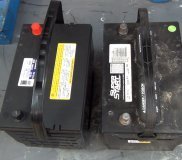You will not identify an open fuse link by looking at it. I assume you have those that are wires spliced into the wiring harness. Very large plug-in fuses are also called fuse links but those are obviously different. Those are also found on much newer cars.
Fuse link wires are standard wire but they're a smaller gauge than the rest of the wires they protect so they are the weak link in the chain. Don't replace them with regular wire of any gauge. Fuse link wires have insulation that is designed to not burn or melt. You will not see any visible damage to a bad one. To test them, tug on them. If one is good it will act like a wire. If it is burned open it will act like a rubber band.
One potential reason you have things working intermittently is when a wire burns open it arcs and that leaves a carbon trail behind. Under the right conditions a little current can flow through that carbon, (just like undesired carbon-tracking in a distributor cap), and some things will get enough current to work.
You can buy fuse link wires at any auto parts store. It is sold by color which corresponds to its gauge and current rating. One piece is long enough for two or three repairs. In some cases you can also cut open the burned link, find the ends of the wire, and solder them together. Most links are three to five inches long. You only need a small fraction of an inch of that smaller diameter wire to protect the circuit. Don't seal the splice with electrical tape. That will let moisture in leading to corrosion in the near future, and it unravel into a gooey mess on a hot day. Use heat-shrink tubing with the hot-melt glue inside to seal the joint.
Saturday, September 14th, 2013 AT 12:01 AM




